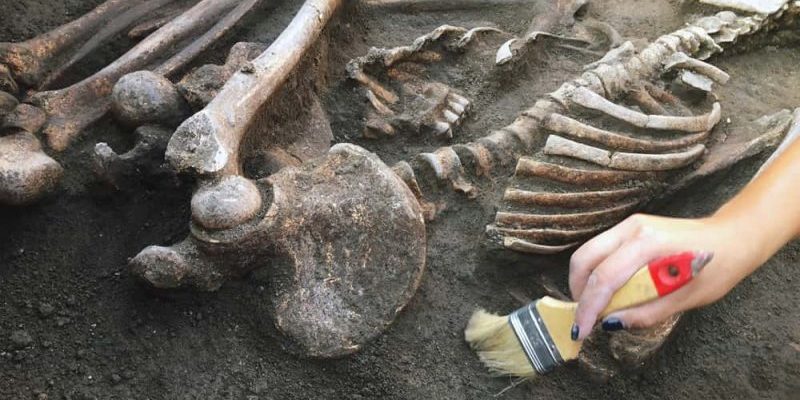We explain what homo erectus is, its history, also, what are its general characteristics, types and examples.
What is homo erectus?
His name: Homo erectus means in Latin "erect man", that is, "standing man" , although initially he was baptized as Pithecantropus erectus , which means "standing ape-man". These names are due to the fact that it was the most primitive human fossil with the smallest cranial capacity discovered at the end of the 19th century (1891), for which it was assumed that it would be the first fully bipedal human species.
Already extinct, Homo erectus emerged about 2 million years ago and disappeared approximately 143,000 - 50,000 years ago, depending on the subspecies.
Origin of Homo erectus

The Homo erectus appeared in Africa and was the first species to have proportions similar physical body to those of the current human being , with indicators of life adapted to the soil and not the trees. Then it would have spread throughout part of Europe and especially Asia , where its largest fossil deposits would be found.
Often, the African members of the species were called Homo ergaster , since Homo erectus is often more specifically referred to as the Asian members of the species. However, today it is assumed that it was a species with a lot of variability depending on its habitat.
Characteristics of the Homo erectus
The Homo erectus already has the configuration of the body needed to walk up away from the ape and approaching the human being today. It is assumed that you could even run long distances. All of this seems to suggest that it is the direct ancestor of contemporary Homo sapiens.
The erectus also had a cranial capacity of 940 ml , halfway between the gorilla (600ml) and modern humans (1200-1500ml). Its brain was in a low and angular cranial vault that was modified throughout its evolution and allowed the emergence of individuals with greater cranial capacity (up to 1100ml) as the species changed. This positions it above Homo habilis and Homo georgicus .
In addition, it had a strong jaw and no chin , with small teeth, as well as a robust body that could reach 1.80 meters in height and presented a marked sexual dimorphism, even greater than in the case of Homo sapiens .
Power of the Homo erectus

It is thought that this species was hunter and scavenger, given the lithic technology (stone tools) that it developed. Something that, in addition, could go hand in hand with the suspicion that Homo erectus was the first hominid to know fire and use it to cook their food.
The bones found show clear signs of hypervitaminosis , which suggests that they would have a diet rich in red meat.
Homo erectus Society
The Homo erectus would have handled some lithic technology (stone) for the manufacture of weapons (axes, spears, knives) probably used for hunting large animals . These tools become less and less rudimentary as the species grows and diversifies.
Everything indicates that he lived in small groups, of around 30 people , and that they had developed a certain level of exchange and socialization between tribes , probably for the exchange of information, goods and women and to avoid the genetic impoverishment of inbreeding.
These associations could even be more durable and serve to hunt a large animal together , after which the spoils were divided and dispersed again. Despite this, it is unlikely that this species handled articulate language .
Java man
The name given to the first Homo erectus found was "Java man", since it was found on the island of the same name, in Indonesia, in 1891 . Its discoverer was the Dutch anatomist Eugène Dubois, who baptized it Anthropopitecus erectus , a name that he later changed to Pithecanthropus erectus .
Importance of Homo erectus

This species was the first inveterate traveler of the genus Homo that left Africa and spread to southern Europe and especially to Asia. This allowed it to diversify enormously over the centuries, which is key in the history of human evolution.
Homo erectus is often thought to be a good candidate for being the pre- Homo sapiens species , which would make it our evolutionary ancestor. This, however, seems contradicted by the findings in the Solo River , which appear to have lived 50,000 years ago, thus being contemporary with Homo sapiens .
Homo erectus subspecies
The subspecies known so far of Homo erectus are:
- Homo erectus erectus or Java Man
- Homo erectus pekinensis or Peking Man
- Homo erectus soloensis or Solo Man
- Homo erectus latianensis or Latian Man
- Homo erectus nankinensis or Nanking Man
- Homo erectus yuanmouensis or Yuanmou Man
- Homo ( erectus ) ergaster
- Homo ( erectus ) palaeojavanicus or Meganthropus
- Homo ( erectus ) tautavelensis or Man of Tautavel
Archaeological sites of Homo erectus
The main archaeological sites of this species are in Asia: China and Java . In China they are found in Zhoukodian, Jinniu Shan, Yiyuan, Yuanmou, Hexian, Chaoxian, Dali, Gonwanling, Yunxian, Maba and Bose Basin. In Java are Modjokerto, Sangirán, Trinil and Ngandong.
Extinction of Homo erectus
 The Homo erectus began his disappearance from the face of the earth about 70,000 years ago , at the lower and middle Pleistocene and links it to the call Theory of Toba catastrophe, which assumes the eruption of a megavolcán on Lake Toba in Indonesia.
The Homo erectus began his disappearance from the face of the earth about 70,000 years ago , at the lower and middle Pleistocene and links it to the call Theory of Toba catastrophe, which assumes the eruption of a megavolcán on Lake Toba in Indonesia.However, with the species having so much variation throughout the world, it is estimated that many of the last Homo erectus species may have survived to coexist with the first Homo sapiens .
Human evolution
The evolution of the human being is a diverse and complex process that involves numerous species of the genus Homo , all descendants of the first African bipedal apes, also precursors of species such as the chimpanzee ( Pan troglodytes ), and ancestors and evolutionary relatives of the current human being ( Homo sapiens ).This process began about 6 million years ago , with a common ancestor between anthropoid monkeys and the first hominids.
The above content published at Collaborative Research Group is for informational and educational purposes only and has been developed by referring reliable sources and recommendations from technology experts. We do not have any contact with official entities nor do we intend to replace the information that they emit.
MA student of the TransAtlantic Masters program at UNC-Chapel Hill. Political Science with a focus on European Studies. Expressed ideas are open to revision. He not only covers Technical articles but also has skills in the fields of SEO, graphics, web development and coding. .
Leave a reply
Your email address will not be published. Required fields are marked *Recent post

Sport: What Is It, Types, Risks, Features, Characteristics and Examples

Dogs: Emergence, Features, Characteristics, Feeding and Breeds

Story: Definition, Elements, Structure, Features and Characteristics

